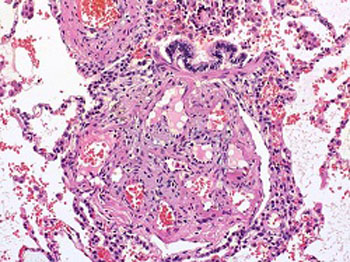Noninvasive Test May Predict Severity of Pulmonary Arterial Hypertension
By LabMedica International staff writers
Posted on 28 Jun 2016
Researchers report that rising blood levels of the hematoma derived growth factor (HDGF) protein are linked to increasing severity of pulmonary arterial hypertension (PAH). Their results, using a newly developed ELISA test, showed a dose-response critical for demonstrating preliminary, proof-of-principle research, and could lead to a noninvasive, more specific test for PAH.Posted on 28 Jun 2016
“This has the potential to be a much more specific readout for the health of the lungs than what we currently measure using invasive cardiac catheterization,” said study leader Prof. Allen Everett, MD, Johns Hopkins Medicine (Baltimore, MD, USA), “It could really have value in making decisions about when to escalate therapy and when to ease it because at present, it’s difficult to determine whether someone’s disease is getting better or worse, especially in children.”

Image: Lung tissue with lesions caused by pulmonary hypertension (Photo courtesy of Bulent Celasun, MD / Wikimedia).
High blood pressure in the arteries leading from the heart to lungs is distinct from the most common forms of high blood pressure and can be difficult to diagnose, with shortness of breath frequently being the first or only symptom. While there’s no cure for PAH, there are an increasing number of drugs available, while lung transplants are a last-resort therapy. Drug treatment for PAH is designed to help relax arterial walls, dilate blood vessels, and thin the blood. Patients can also benefit from oxygen therapy and surgery to reduce pressure on the right side of the heart. Treatments are complicated and carry numerous serious side effects so finding measures that allow clinicians to minimize drug therapy will reduce side effects, as well as cost.
Toward reducing the uncertainty, Prof. Everett and colleagues developed a new test to measure levels of HDGF in blood. HDGF is important for formation of new blood vessels in the lung – a process known to readily occur in lungs of PAH patients. They compared blood samples from 39 patients with severe PAH who had failed treatment and were waiting for lung transplants, and a control group of 39 age-, gender- and race-matched healthy volunteers. The resulting median HDGF levels in patients were about 7 times higher than in controls (patients 1.93 versus controls 0.29 nanograms/milliliter).
When the team followed up by testing an additional 73 patients over 5 years, the results were dramatic. Patients with HDGF level greater than 0.7 nanograms/milliliter had more extensive heart failure and walked shorter distances in a 6-minute walking test. Also, HDGF was lower in survivors than nonsurvivors (0.2 versus 1.4 nanograms/milliliter), with elevated levels associated with a 4.5-fold increased risk of death even after adjusting for age, pulmonary hypertension type, heart function, and levels of a protein that in blood predicts heart failure. These findings suggest that HDGF has a distinct advantage to current clinical measures for predicting survival in patients with PAH.
Although the biochemical details of why there is a link between PAH and HDGF remain unknown, Prof. Everett suspects HDGF levels might increase to spur blood vessel healing when arteries stretch in the lungs due to PAH. HDGF is a unique marker compared to current clinical measures of PAH as it does not come from the heart and reflects more specifically how the disease affects the lungs.
Cautioning that further research is needed, Prof. Everett these early results already point toward the value of using levels of HDGF in diagnosing and tracking therapy in adults with PAH. “This could be a cheap and easy way to say: ‘Oh good, your levels are going down. Let’s try to take away one of your medicines and see how that works,’” he explains, “Or if you know from the very beginning of their treatment that someone isn’t responding to any medicines, you can get them on the list for a lung transplant much sooner.”
More research is needed to reveal: whether levels change as drug therapy eases symptoms during the course of a disease, whether the results hold true in children with PAH, and whether HDGF can be used to predict patients at risk of developing PAH.
The study, by Yang J et al, was published online June 2, 2016, in the American Journal of Respiratory and Critical Care Medicine.
Related Links:
Johns Hopkins Medicine







 Analyzer.jpg)






